Braibant S., Giacomelli G., Spurio M. Particles and Fundamental Interactions: An Introduction to Particle Physics
Подождите немного. Документ загружается.


10.8 Total and Elastic Cross-Sections at High Energy 299
1000
100
10
1
0.1
0.01
0.001
0.0001
0 0.5 1.0 1.5
⏐t⏐ (GeV / c)
2
dσ/ dt [mb / (GeV / c)
2
]
10
–5
10
–4
10
–3
10
–2
10
–1
10
2
10
1
a
b
0 0.4 0.8 1.2 1.6 2.0 2.4
–t (GeV
2
)
dσ/ dt (mb / GeV
2
)
p-p
s = 53 GeV
p-p
p-p, s = 546 GeV
Fig. 10.21 Differential cross-section, d=dt as a function of jtj, for elastic collisions (a) pp and
pp at
p
s D 53 and 546 GeV; (b) pp at
p
s D 1:8 TeV [10G93]
scattering angle, for example, the transferred four-momentum squared, Q
2
Djtj.
The elastic differential cross-section d=dt for pp, p
p reactions at the CERN ISR
and Sp
pS, shown in Fig. 10.21, peaks at small angles (t 'p
2
2
at small ). The
distribution can be divided into four angular regions (of which only the last two are
evident in the figure):
1. The Coulomb region jt j < 0:001 (GeV/c)
2
. The collision is due to the
electromagnetic interaction and the cross-section can be explicitly calculated.
2. The nuclear-Coulomb interference region for 0:001 < jtj <0:01.GeV=c/
2
.
3. The nuclear diffractive region 0:01 < jt j <0:5(GeV/c)
2
. The interaction is
basically due to the strong interaction only; the most important parameter is the
slope b of the diffraction pattern. Here, the differential cross-section depends
on t as
d=dt D Ae
bt
: (10.75)
With increasing energy, b increases according to the approximate formula b '
8 C 0:56 ln s, with a narrowing of the forward elastic peak. For a wider range of
t, the dependence is of the type Ae
btCct
2
.
4. The large angles region jtj >0:5.GeV=c/
2
. It is characterized by a very small
elastic cross-sections and, for pp at
p
s ' 53 GeV, a valley-peak structure,
similar to an optical diffraction pattern.
To measure the elastic differential cross-section, the number of interactions per unit
of time and of transferred four-momentum t must be counted. For a collider, the
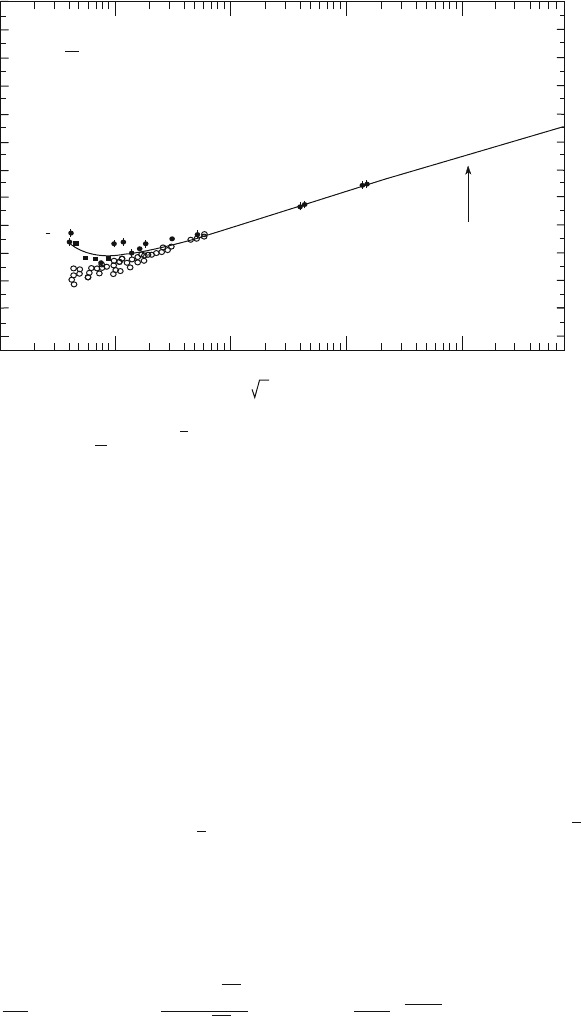
300 10 High Energy Interactions and the Dynamic Quark Model
t = –0.02 GeV
2
dσ
dt
~ e
–Bltl
pp
α' = 0.25 GeV
–2
TEVATRON
LHC
UA4
E710
ISR
1
10
B (GeV
–2
)
10
3
10
2
10
4
30
28
26
24
22
20
18
16
14
12
10
8
6
s (GeV)
pp
Fig. 10.22 Slopes B D b
pp
and D b
pp
plotted as a function of the momentum in the laboratory
system for elastic pp and
pp collisions
luminosity L (Sect. 3.3) is the number that, multiplied for the total cross-section ,
gives the total number N of interactions per time unit: N D L.Theintegrated
luminosity over a time interval dt is
L D
Z
Ldt (10.76)
The integrated luminosity L is a fundamental quantity. By definition, its units are the
inverse of the cross-section (for example, nb
1
, pb
1
). With an integrated luminosity
of 1 pb
1
, one event is expected for a process that has a cross-section of 1 pb D
10
36
cm
2
.
Figure 10.22 shows the energy dependence of the elastic scattering slope b
(10.75) measured at an average value jtj'0:2 (GeV/c)
2
in the interval 0:15 <
jtj <0:4(GeV/c)
2
. Note that b
pp
first decreases and then increases with
p
s,
reaching the value b
pp
. The data are consistent with a low-p
t
model in which the
hadron is basically an almost black disk. Using the analogy with classical optics,
the diffraction pattern of an opaque disk of radius R and opacity a (a D 0 for a
black disc, a D 1 for a completely transparent disk) is described by the order 1 .J
1
/
Bessel function:
d
dt
' .1 a/R
2
ˇ
ˇ
ˇ
ˇ
J
1
.R
p
jtj/
R
p
jtj
ˇ
ˇ
ˇ
ˇ
2
' .1 a/
R
4
4
e
R
2
jtj
4
: (10.77)
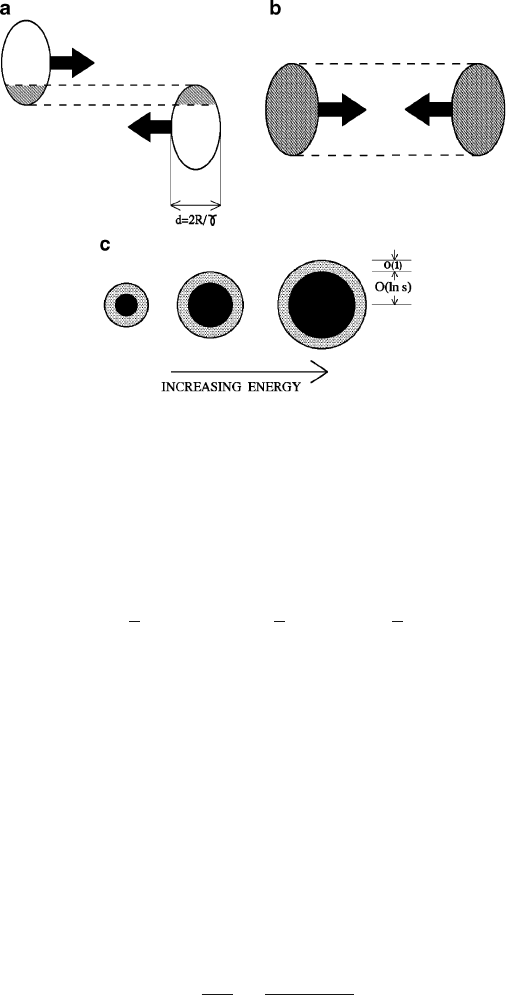
10.8 Total and Elastic Cross-Sections at High Energy 301
Fig. 10.23 Schematic representation of the status of two hadrons before collision for (a) peripheral
and (b) central collisions. Due to relativistic effects, the two hadrons contract along the direction
of motion. (c) Sketch of the increase with energy of the hadron size and opacity (the relativistic
contraction is not shown)
The approximation is valid for jt j <0:2(GeV/c)
2
; by comparing this expression
with d=dt e
bt
(10.75), one obtains b D R
2
=4. From this relation, the disk radius
R can be deduced, that is,
R ' 2
p
b.GeV
1
/ ! 2
p
b.„c/ ' 0:4
p
b.fm/: (10.78)
The apparent proton radius increases with c.m. energy of the elastic reaction
because b ln s, as schematically illustrated in Fig. 10.23.
10.8.2 Total Cross-Sections
In a model of the diffraction pattern of the incident particle wave on a target,
similar to that of classical optics, the total cross-section
tot
is related to the elastic
differential cross-section at t ! 0 (optical theorem). The measurement of
tot
may
be made through the total number of collisions, both elastic and inelastic, and the
integrated luminosity L
tot
D
N
tot
L
D
N
el
C N
inel
L
: (10.79)

302 10 High Energy Interactions and the Dynamic Quark Model
Experiments at the CERN SppS and at the Fermilab Tevatron collider measured
tot
using a combination of both methods. Usually, the integrated luminosity L is
not known with an accuracy better than 10%. The main results can be summarized
as follows:
1. The total cross-section and the slope b of the elastic differential cross-section
increase with energy: the proton radius (10.78) seems to become larger at high
energy, Fig.10.23.
2. The opacity a D 2
el
=
tot
increases with energy, indicating that the proton
becomes not only larger, but also “darker” with increasing energy, as shown in
Fig. 10.23.At
p
s D 1:8 TeV, one has a ' 0:50, which is lower by a factor of 2
than the value a D 1 for the diffraction on a black disk.
3. The shape of the “diffraction pattern for elastic collision,” Fig. 10.21 resembles
that obtained in classical optics.
4. The interpretation of the elastic and total cross-section as a function of energy
was made in terms of different, even contradictory, models. Within QCD,
the growth of
tot
with energy as
tot
s
˛
0
can be associated with the
increasing contribution of soft gluon exchange (˛
0
is a positive parameter). This
behavior would be divergent at large s; these divergences must be overcome with
appropriate mathematical methods.
10.9 High Energy Inelastic Hadron Collisions at Low-p
t
In collisions between two high energy hadrons, particle production is mainly due to
processes where the average transverse momentum p
t
is small. At the beginning of
the 1970s, it was believed that the basic characteristics of these processes were:
1. The number of charged particles produced, i.e., the charge multiplicity, increases
logarithmically with the c.m. energy
2. The cross-section depends exponentially on the transverse momentum. The
average transverse momentum of produced particles is hp
t
i'350 MeV/c,
roughly constant and independent from the energy and type of colliding hadrons
The increase in the charged multiplicity when the c.m. energy of the colliding
hadrons increases is one of the main features of high energy collisions; this can be
easily measured. Only a small fraction of the c.m. energy is converted into mass of
the produced particles. Most of the energy remains in the form of kinetic energy
of the outgoing particles. For example, at
p
s D 62 GeV, the average multiplicity
of charged hadrons (mostly pions) is 12, while the available energy would allow the
production of several hundred pions.
The analysis of the charge multiplicity in hadron-hadron, lepton–nucleon and
e
C
e
collisions shows that the average number of produced particles only depends
on the available c.m. energy (
p
s) and that it is independent of the type of colliding
particles (see Fig. 9.19). Table 10.2 gives the average number of hadrons produced

10.9 High Energy Inelastic Hadron Collisions at Low-p
t
303
Table 10.2 Average numbers of particles (hadrons) pro-
duced in inelastic pp collisions at
p
s D 53 GeV and in
pp collisions at
p
s D 540 and 1,800 GeV. At the higher
energy, the number of neutral particles is equal to half of
those charged. At LHC (
p
s D 14 TeV), the estimated
number of charged hadrons per collision is 80
Particle type pp pp pp
p
s(GeV) 53 540 1,800
Charged 12.0 29.0 40
Neutral 6.0 14.5 20
C
4:7
4:3
23.9
0
4.5 12
K
˙
K
0
0:46
0:33
2.24
K
0
C K
0
0.79 2.24
p
p
1:6
0:15
1.45
n C
n 1.75 1.45
C
C˙
0
C˙
0
0.53
˙
C
C ˙
C˙
C
C ˙
0.27
C
C
0
C
0
0.20
in inelastic pp collisions at
p
s D 53 GeV and in pp collisions at
p
s D 540
and 1,800 GeV. At
p
s D 1:8 TeV, the average charged multiplicity is 40 and
the number of neutral hadrons is half of the charged ones. The dominance of pion
production should also be noted.
The average transverse momentum .
p
t
/ in a single event and the average
transverse momentum in N events (h
p
t
i) are respectively defined as
p
t
D
1
n
n
X
iD1
ˇ
ˇ
p
t
ˇ
ˇ
i
Ihp
t
iD
1
N
N
X
j D1
p
tj
; (10.80)
where n is the number of produced charged hadrons, each with momentum jp
t
j
i
.
Figure 10.24 shows the average transverse momentum of charged hadrons produced
in pp and
pp high energy collisions as a function of
p
s. Although it remains small,
it can be observed that h
p
t
i increases slowly with
p
s.
10.9.1 Outline on High Energy Nucleus-Nucleus Collisions
High energy nucleus-nucleus collisions have been studied since the end of the
1980s using
8
O,
16
Se
82
Pb ion beams of 15 GeV/nucleon at Brookhaven and
200 (158 for
82
Pb) GeV/nucleon at the CERN SPS. The results show that the

304 10 High Energy Interactions and the Dynamic Quark Model
Tevatron
ISR
SppS
0.5
0.4
0.3
10
1
10
2
10
3
s (GeV)
< p
t
> (GeV)
Fig. 10.24 Average transverse momentum of charged hadrons produced in high energy hadronic
collisions as a function of the c.m. energy
nucleus-nucleus collision can be explained as a series of hadron–nucleus collisions
(superposition model). Only few nucleons of the projectile (or target) interact
inelastically, producing a heavy nuclear fragment, some light fragments and several
spectator nucleons. About 20% of these nucleons reinteracts inside the target
nucleus. The hadron–nucleus interaction is thus considered as a superposition of
hadron-hadron interactions.
One of the most used models in Monte Carlo simulations of nucleus-nucleus
interactions is the Glauber model of multiple nuclear scattering: a hadron crossing a
nucleus can undergo multiple interactions; in each interaction, hadrons are produced
which may in turn interact within the same nucleus, giving rise to a intranuclear
cascade. The nucleus-nucleus interactions are important in the study of cascades
induced by high energy cosmic rays (protons, helium nuclei and heavier nuclei)
with nuclei in the upper atmosphere [G90].
Quark-gluon plasma. High energy nucleus-nucleus collisions are used to search
for the possible state of matter denoted as quark-gluon plasma. The very high
temperatures and densities achieved in the collisions should, for a very short time,
allow quarks and gluons to exist in a free state, i.e., no longer confined in hadrons, in
a kind of “soup” or plasma. It is believed that this state of matter has existed around
10
6
s after the Big Bang. The Brookhaven Relativistic Heavy Ion Collider (RHIC),
devoted to these studies, became operational in June of 2000, with gold ions which
collided at energies between 56–130 GeV/nucleon. They may have indications for
a quark-gluon plasma which behaves more like a liquid than a gas [10w1]. At
LHC, the ALICE experiment plans to study in detail the interactions between
heavy nuclei at energies up to 5.5 TeV/nucleon. The study of the properties of

10.10 The LHC and the Search for the Higgs Boson 305
quark-gluon plasma can help to understand the origin of particles such as the proton
and the neutron, and may also have important implications for our understanding of
cosmology.
10.10 The LHC and the Search for the Higgs Boson
As shown in Chap. 9, the Standard Model of electroweak interactions has suc-
cessfully gathered an impressive amount of experimental confirmations. Indeed,
high-precision measurements and a thorough verification of the Standard Model
were performed in 1989 by the four LEP experiments at CERN (ALEPH, DELPHI,
L3 and OPAL) and the SLD experiment at Stanford. Nevertheless, the neutral Higgs
boson which is an indispensable ingredient in the Standard Model, used to explain
the origin of the masses, is still eluding experimental discovery. As described
in Sect. 11.5, the Higgs boson is introduced through the spontaneous symmetry
breaking mechanism responsible for generating masses of all known particles.
The advent of the Large Hadron Collider (LHC) at CERN (see Sect. 3.3), the
highest-energy particle accelerator in the world, allows one to extend the search
for the existence of the Higgs boson far beyond what was achieved by previous
experiments. In addition, new particles predicted by extensions of the Standard
Model, for example, the supersymmetric models (Sect. 13.2), are searched for at
LHC.
On September 10, 2008, the proton beams were successfully circulated in the
main LHC rings, but 9 days later, operations were halted due to a serious fault. After
a long repair and test period, the LHC was restarted in March 2010, and each beam
was accelerated up to 3.5 TeV (i.e., half of the design nominal beam energy). The
first beam collisions at a center-of-mass energy (
p
s) of 7 TeV were immediately
recorded by the detectors installed around the four LHC collision points; these
detectors are ATLAS, CMS, ALICE and LHCb. The first two experiments are large
omnipurpose detectors, while ALICE is mainly devoted to the search for the quark-
gluon plasma state (Sect. 10.9.1); the LHCb experiment is instead designed for high
statistic studies of CP violation (Sect.12.5). LHC will likely continue to operate at
this energy for a few years, but with an ever increasing instantaneous luminosity (in
2011, reaching 3:3 10
33
cm
2
s
1
). LHC will not likely be operated at its design
collision energy of 14 TeV until 2014.
On the experimental side, a proof of the high quality reached by the LHC
detectors is, for instance, the invariant mass spectrum of opposite-sign muon pairs
obtained with the CMS data, see Fig. 10.25. A muon pair can be produced by the
combination of background events, or from a Drell–Yan process, see Sect. 7.14.2.
Referring to Fig. 7.20, at the LHC c.m. energy, the exchange of a Z
0
, in addition to
the , is also possible. In the case of the Drell–Yan mechanism, the q
q vector meson
resonances and the Z
0
on-mass shell are observed as peaks visible in Fig. 10.25.
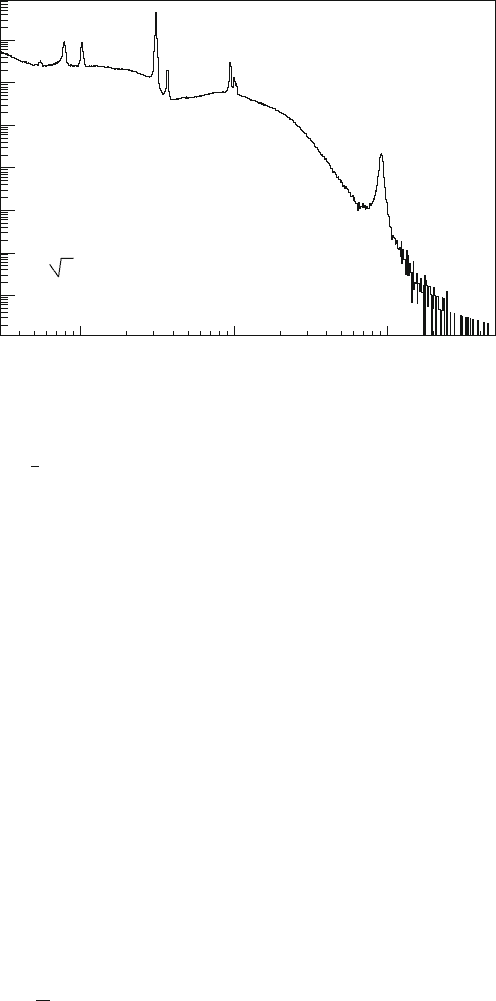
306 10 High Energy Interactions and the Dynamic Quark Model
m
+
m
–
mass (GeV/c
2
)
1 10 10
2
Events / GeV
1
10
10
2
10
3
10
4
10
5
10
6
CMS Preliminary
s = 7 TeV, L
int
= 40 pb
–1
η
ρ,ω
φ
J/ψ
ψ'
Υ(1,2,3S)
Z
Fig. 10.25 Full invariant mass spectrum of opposite-sign muon pairs measured by the CMS
experiment. Different subdetectors are involved in the measurement of the muon energy from the
100 MeV range to hundreds of GeV. The plot corresponds to an integrated luminosity of 40 pb
1
at the c.m. energy
p
s D 7 TeV [10C11]
10.10.1 Higgs Boson Production in pp Collisions
Within the Standard Model framework, the Higgs boson is characterized by a
complete knowledge of its couplings to all quarks, leptons and gauge bosons, but
a complete ignorance of its mass. This ignorance implies searches over a broad
mass range. We need to consider various primary states that can produce a H
0
and
different H
0
decay modes.
Direct Higgs boson searches at LEP (Sect.9.8.4) relied on the “Higgsstrahlung”
process e
C
e
! Z
! HZ shown in Fig. 9.20a. Combining the results of the four
LEP experiments, a lower limit on the mass of the Standard Model Higgs boson
was obtained: M
H
> 114:4 GeV at the 95% confidence level. As a consequence,
the LHC experiments must search for the Higgs boson in a broad mass interval:
100 GeV < M
H
< 1 TeV. Moreover, in a hadronic collider, the Higgs boson
production mechanisms are completely different from those at LEP. At LHC, the
dominant Higgs boson production mechanism are:
• The gluon fusion: gg ! H showninFig.10.26a.
• The vector boson fusion (VBF): qq ! qqV
V
! qqH showninFig.10.26b.
It should be mentioned that searches for the Higgs boson are also performed
at the Tevatron p
p Collider at the Fermilab. Here, the second dominant Higgs
production mechanism after the gluon fusion is due to quark-antiquark annihilation.
In antiproton-proton colliders, antiquarks are available as valence quarks, carrying a
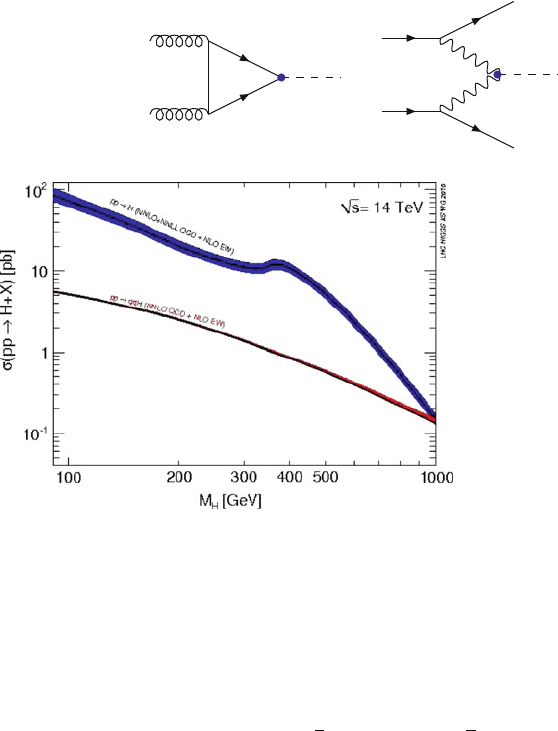
10.10 The LHC and the Search for the Higgs Boson 307
Fig. 10.26 Dominant
Standard Model Higgs boson
production mechanisms at
LHC: (a) Gluon fusion and
(b) Vector Boson Fusion
(VBF)
g
g
H
ab
q
q
V∗
V
∗
H
q
q
Fig. 10.27 Standard model Higgs boson production cross-sections with systematic uncertainties
[10L11] (represented by the line thickness) for the two dominant processes at LHC: the gluon
fusion (pp ! H ) and the vector boson fusion (pp ! qqH)
large fraction of the total antiproton energy; at proton-proton colliders, such as, the
LHC, sea antiquarks typically carry much less energy than the quarks (Fig. 10.11).
The cross-section dependence for the two dominant production mechanisms at
LHC (the gluon fusion and the VBF) is shown in Fig. 10.27 as a function of the
unknown Higgs mass, M
H
, and at a c.m. energy
p
s D 14 TeV. At
p
s D 7 TeV,
the gluon fusion cross-section is about a factor of 3, 5 and 10 smaller at M
H
D100,
400 and 1,000GeV, respectively.
The gluon fusion gg ! H: the dynamics of the gluon fusion mechanism is
controlled by strong interactions. Detailed studies of the effect of QCD radiative
corrections are thus necessary to obtain accurate theoretical predictions [10L11]. In
QCD perturbation theory, the leading order (LO) contribution to the gluon fusion
cross-section is proportional to ˛
2
S
. The main contribution arises from the virtual
top quark loop (see Feynman diagram in Fig. 10.26a), allowing the coupling of
the Higgs boson to the massless gluons. Indeed, as seen in Sect. 9.8.4, the H
0
coupling is proportional to the mass of the fermion to which it couples. As expected,
the lowest order cross-section has large corrections at the next-to-leading order
(NLO) QCD diagrams, which represent one of the main sources of uncertainty.
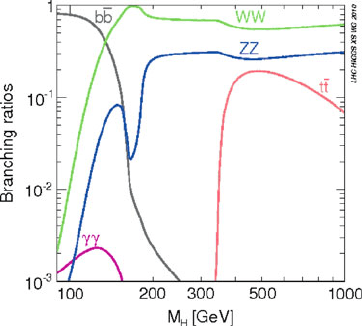
308 10 High Energy Interactions and the Dynamic Quark Model
Fig. 10.28 SM Higgs boson decay branching ratios as a function of M
H
[10L11]
They increase the LO cross-section by about 80–100%. Another uncertainty source
is related to the knowledge of the gluon structure function in the low x region.
Referring to Fig. 10.11, the contribution of the gluons to the structure function
dominates at x<0:2. It means that the energy available for the formation of the
Higgs boson is in most cases smaller than 0:2
2
= 4% of the c.m. energy of the pp
collision. The decrease of the gluon structure function with increasing x is the main
origin of the decrease of .pp ! H/ as M
H
increases.
The vector boson fusion (VBF) qq ! qqV
V
! qqH: the V
can be either
a W
˙
or a Z
0
. The * superscript (as in the following) means that the particle is
off-mass shell, i.e., E
2
¤ m
2
c
4
C p
2
c
2
(see Sect. 4.6).
The calculation of the VBF cross-section needs the convolution with the structure
functions of the incoming quarks. For all possible values of M
H
, the VBF cross-
section is smaller than that of the gluon fusion process (see Fig. 10.27). However,
there is the additional topological signature of the two outgoing quarks participating
in the process and forming jets whose identification could be easier in this
production channel.
10.10.2 Higgs Boson Decays
Following its production, the Higgs boson may decay into a fermion–antifermion or
a vector boson pair, respectively, with a coupling proportional to the fermion mass
and to the boson mass squared. The main decay channels and their branching ratios
(BR, Sect. 4.5.2) are shown in Fig. 10.28. The BRs change significantly across the
considered range of M
H
, yielding many different final states topologies. For this
